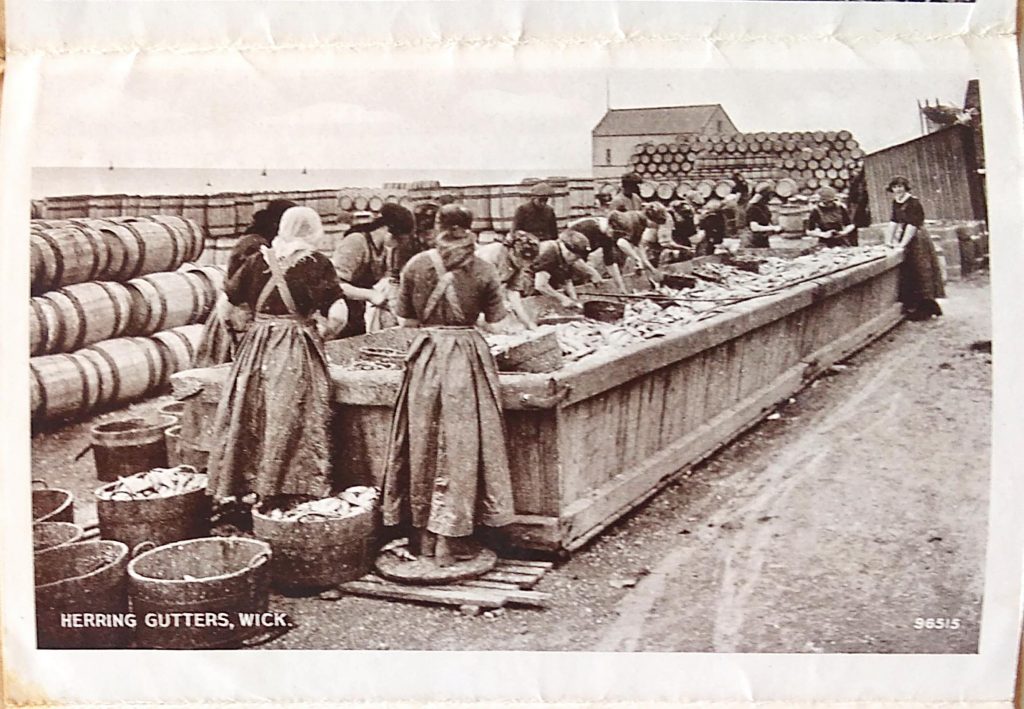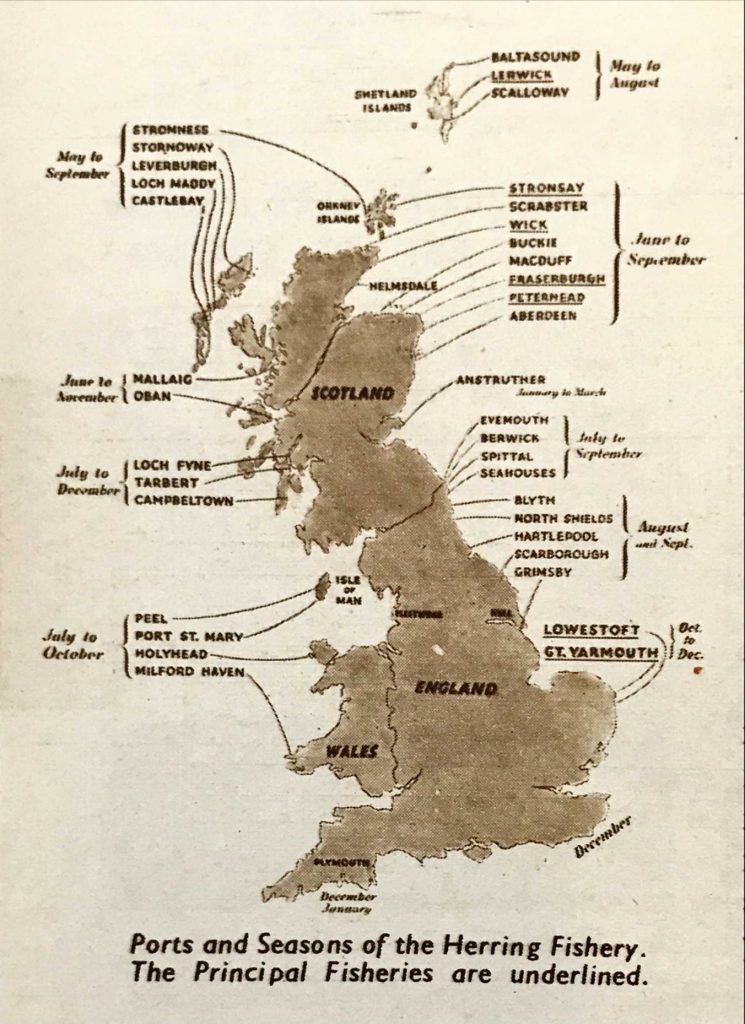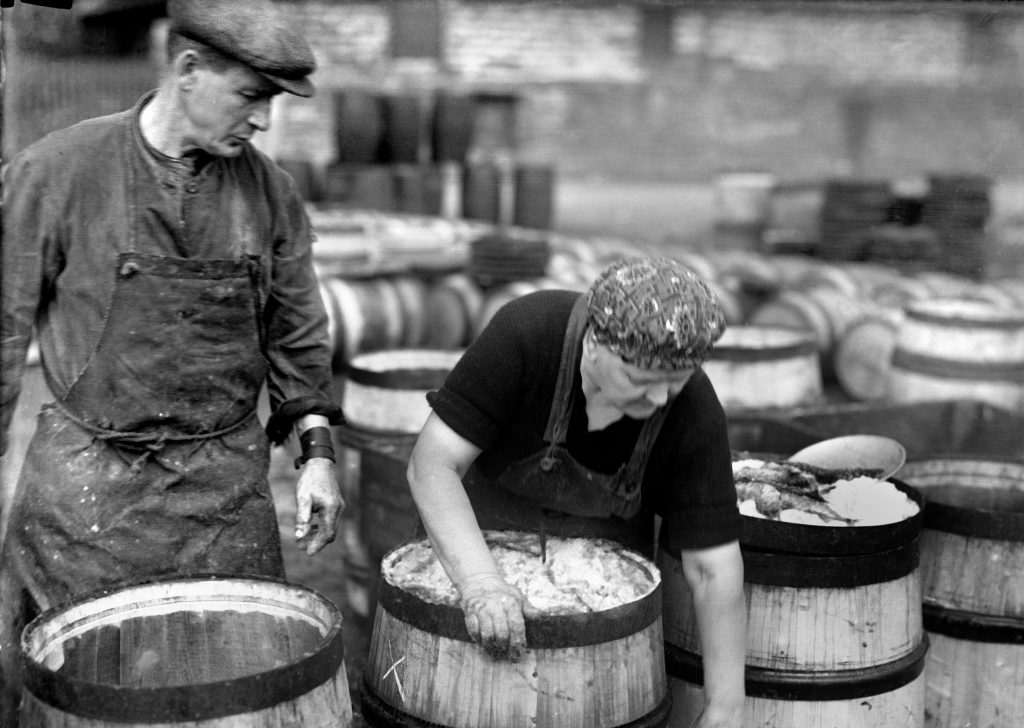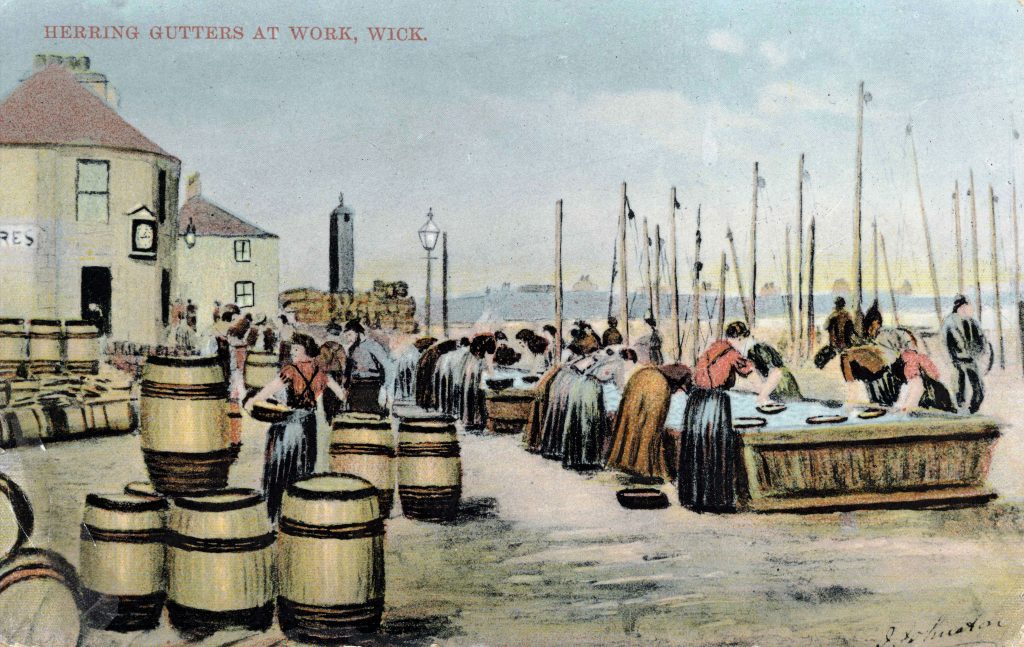
“All along the inner harbour, and in every street and quay, as well as within many large enclosed yards and covered buildings, there are numerous square wooden boxes as big as ordinary- sized rooms, [their]…. sides, however, being only two or three feet high. Into these huge troughs the herring are carried in panniers from the boats the instant they arrive. There [the catch is] …. All tumbled in helter- skelter, pannier after pannier, in a long-continued stream of fish, until the boats are emptied and the troughs are filled. Then come the troops of sturdy females, each armed with a knife in hand [who] range themselves around the trough. The process of gutting [next] commences and is carried on with such ceaseless and untiring rapidity that, unless we had …. request[ed] one of the …. prettiest of these eviscatrixes so as to moderate the rancour of her knife as to let us see what she was doing, we could scarcely have followed her manipulations with the naked eye.”
From James Wilson, A Voyage Round the Coasts of Scotland and the Isles, Vol II, Edinburgh, 1842, pp. 156-157.
The above photograph shows groups of women gutting fish. The herring fishing season in Wick usually ran through June, July and August. The gutters spent around 12 weeks here before following the herring shoals south. Many of the herring girls came from the Hebrides. They stayed in dormitories above fishcuring yards, or lodged with local people.
The worker’s belongings were packed into kists (wooden chests) that were taken to Wick by fishing boat. However, the boats would not take the herring gutters themselves- it was thought that women brought bad luck and so they were not allowed aboard.
The women would work in teams of three; two gutters and one packer. The herring catches were unloaded into large wooden troughs called farlans. The gutters would gut the fish with a single stroke of their knife.
Most women could gut an average of 40 fish each minute but some were significantly faster. Experienced crews were known as ‘first- class women’.
The girls would bind their fingers with strips cut from flour sacks to protect against cuts from the sharp knives used to gut the herring- called ‘cutags’. They were inevitable however, and long days spent with their hands in salt would have been very painful.
After gutting, the packer would then arrange the herring in layers like a rosette, with their bellies facing up, and their heads toward the outside of the barrel. Each layer was given a generous sprinkling of rough salt, under the watchful eye of an experienced cooper.
Herring gutter, Peggy Macleod
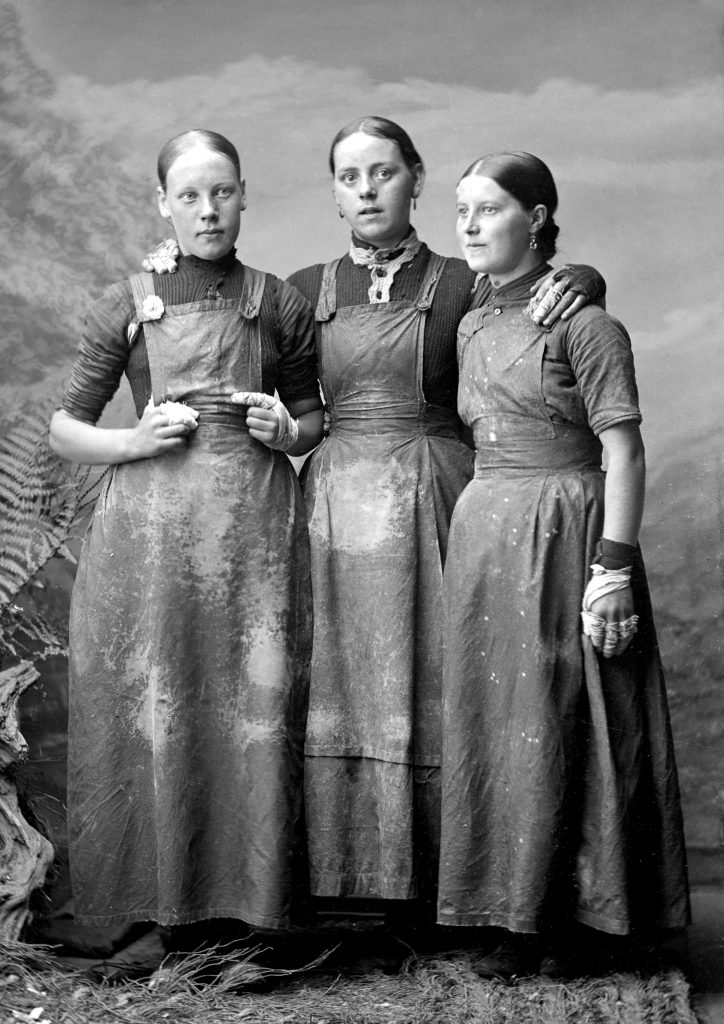
Three herring gutters. This photograph illustrates how the gutters would wrap their fingers in strips cut from flour sacks to protect them from cuts (Courtesy of the Johnston Collection, MJN38086P184)
From correspondence and other documents from the papers of Donald Waters, Fishcurer, we can learn a bit more about the life of a ‘herring girl’. In this case, Peggy Macleod, of 5 Dalemore, Stornoway, Isle of Lewis. We see the relationship that was maintained over a number of years between Peggy and Donald Waters.
Fishcuring companies would recruit herring gutting crews of two gutters and one packer for the season. When payment was agreed all the members of the crew were paid arles, an engagement fee, which was usually ten shillings.
During the hectic herring season, working days were long. Archives reveal that in one week at Wick, each woman in a crew worked 83.5 hours, which averages at 12 hours per day for a seven- day week.
From this letter below to the Steamboat Office in Stornoway enclosing payment for Peggy and her crew’s travel to Wick, we learn that Peggy was the packer in her crew.

Letter to the Steamboat Office in Stornoway enclosing payment for Peggy and her crew’s travel to Wick (Ref: WAT/2)
From Stornoway on Lewis, Peggy travelled to Wick for the herring season, usually from June to September. From October to December she would work at Gorleston on the south east coast of England.
From reading Peggy’s letters, we know many of the Hebridean girls worked in service in Glasgow outside of the herring fishing season.
It was an itinerant way of life, but a necessary one. The girls came from crofts in the Western Isles, where a living could not be made from crofting alone. Members of crofting families would have to leave the Isles temporarily each year to obtain seasonal employment, so they could make enough money to keep the croft going for the rest of the year.
This map shows the Ports and Seasons of the Herring Fishery. The major ports are underlined.
Below are transcripts from four of Peggy’s letters to Donald Waters and Son, Fishcurers in Wick, arranging work for the herring seasons between 1934 and 1939.
Letter 1 … 5 Dalemore, Stornoway 3rd February 1934
Dear Sir,
Would you kindly let us know by return, whether we can depend on you for the Summer season or not as we are anxious to know by now so please let us know by return.
Yours faithfully,
Peggy Macleod
Letter 2 … 5 Dalemore, Stornoway, Lewis 9th May 1934
Dear Sir,
We hear that some curers are fixing up the girls now, so I do hope that things look brighter towards the fishing. I wonder could you have a place for another crew besides our own, as my sister’s crew are in Glasgow at service since Yarmouth time, they stopped in Glasgow on their way from Yarmouth and are now wishing to go back to Wick again for the Summer fishing, so will you kindly let us know by return whether you will be able to take them on or not, if there is a fishing. I hope things will brighten up as ever, as really everybody needs it, however let us hope for the best.
Yours faithfully,
Peggy Macleod
Letter 3 … 5 Dalmore, Stornoway, Lewis 20th January 1936
Dear Sir,
In answer to your letter of the 17th I may tell you we are depending on you for Wick as we did not engage with anyone, although we have had a few letters from curers, we had one from James Sinclair Fish merchant & Curer, Wick, asking for several crews, so I could not get any crews as they are all engaged, seeing you asked us about Wick in Gorleston we were not to engage with anyone till we were to hear from you, so everything will be all right, on the terms arranged.
Yours faithfully,
Peggy Macleod
Letter 4 … 5 Dalmore, Stornoway, 2nd January 1939
Dear Sir,
I am sorry for not getting your letter when it arrived home, as I waited in Glasgow till last Friday 30th Dec. and they did not send me your letter so I hope it will be all right, I have not seen Annie Macarthur since I came and for my other neighbour Mary Morrison I don’t think she will be able to get away in the Summer, so then I don’t know really what to say as I have not a crew seeing Dolly is not going and besides I am not sure whether I shall be able to get away myself or not as the old folk are getting frail. So I can’t make any arrangements towards the summer as yet. Thanking you very much for your offer, but sorry I can’t make any arrangements so far the way I am placed. I am pleased to tell you that I got away with Miller to Lowestoft in Oct. and that was how I stopped in Glasgow. Wishing you all a Happy New Year. Again thanking you for your kindness always towards us.
Yours faithfully,
Peggy Macleod
